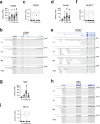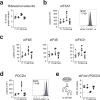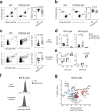An integrated proteome and transcriptome of B cell maturation defines poised activation states of transitional and mature B cells
- PMID: 37612319
- PMCID: PMC10447577
- DOI: 10.1038/s41467-023-40621-2
An integrated proteome and transcriptome of B cell maturation defines poised activation states of transitional and mature B cells
Abstract
During B cell maturation, transitional and mature B cells acquire cell-intrinsic features that determine their ability to exit quiescence and mount effective immune responses. Here we use label-free proteomics to quantify the proteome of B cell subsets from the mouse spleen and map the differential expression of environmental sensing, transcription, and translation initiation factors that define cellular identity and function. Cross-examination of the full-length transcriptome and proteome identifies mRNAs related to B cell activation and antibody secretion that are not accompanied by detection of the encoded proteins. In addition, proteomic data further suggests that the translational repressor PDCD4 restrains B cell responses, in particular those from marginal zone B cells, to a T-cell independent antigen. In summary, our molecular characterization of B cell maturation presents a valuable resource to further explore the mechanisms underpinning the specialized functions of B cell subsets, and suggest the presence of 'poised' mRNAs that enable expedited B cell responses.
© 2023. Springer Nature Limited.
Conflict of interest statement
The authors declare no competing interests.
Figures








References
-
- Allman D, et al. Resolution of three nonproliferative immature splenic B cell subsets reveals multiple selection points during peripheral B cell maturation. J. Immunol. 2001;167:6834–6840. - PubMed
-
- Wen L, et al. Evidence of marginal-zone B cell-positive selection in spleen. Immunity. 2005;23:297–308. - PubMed
-
- Merrell KT, et al. Identification of anergic B cells within a wild-type repertoire. Immunity. 2006;25:953–962. - PubMed
Publication types
MeSH terms
Substances
Grants and funding
LinkOut - more resources
Full Text Sources
Molecular Biology Databases

